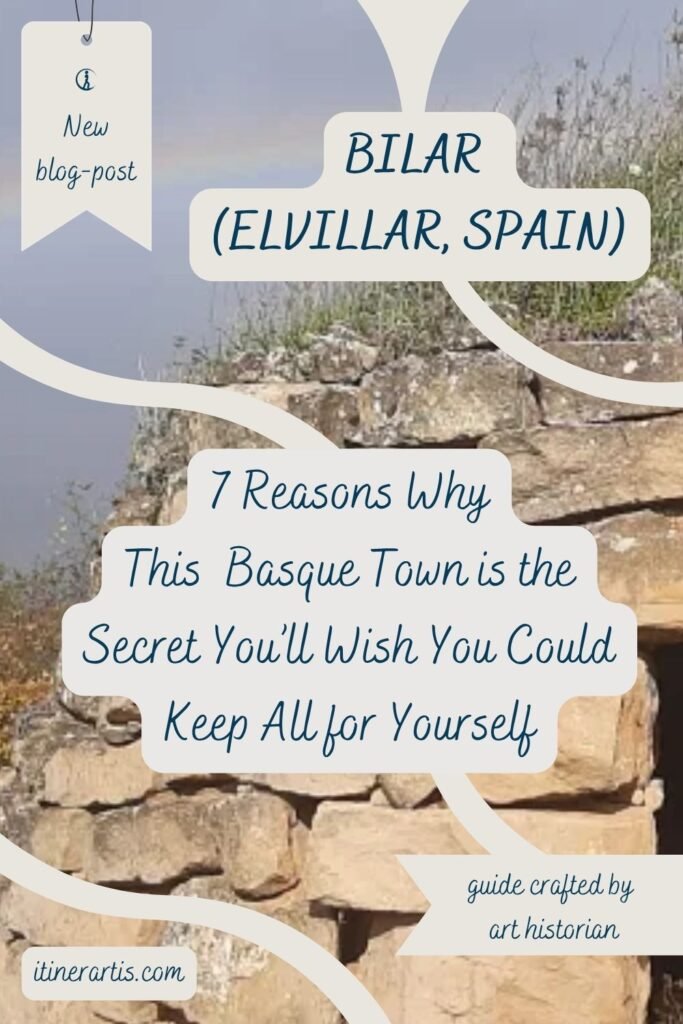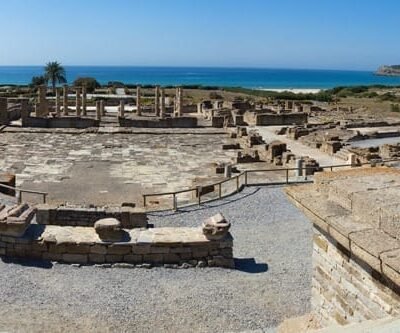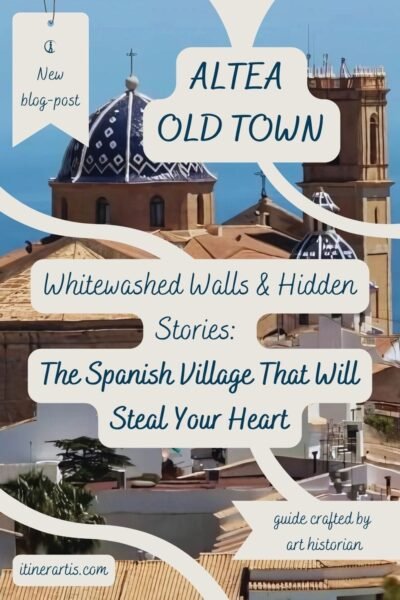Dolmens, Wine, and Magic Beauty — 7 Reasons Bilar (Elvillar, Spain) Is the Basque Secret You’ll Wish You Could Keep
There are places you visit—and places you feel you’ve somehow always known. Bilar (Elvillar, Spain) belongs to the second kind. The road in narrows, curving past vineyards that shimmer silver-green under the wind. No billboards. No fanfare. Just a stillness that gathers, as if the land had been expecting you all along.
![Dolmen of Sorginaren Txabola, Bilar (Elvillar, Spain) [Photograph]. Credit: javieritopito. Licensed under CC BY-SA 2.0.](https://itinerartis.com/wp-content/uploads/2025/05/19.-Dolmen-of-Sorginaren-Txabola-Bilar-Elvillar-Spain-Photograph.-Credit-javieritopito.-Licensed-under-CC-BY-SA-2.0.jpg)
Dolmens emerge from the fields like forgotten altars, half-sunk in earth and memory. The air smells faintly of wild thyme and distant harvests. In the haze beyond, the Sierra de Cantabria rises like a half-formed thought—neither fully mountain nor cloud. The village itself clings quietly to the landscape, its stone walls the color of sun-warmed clay, its rhythm older than time zones. A bell tolls. A dog barks once, then disappears into the silence.
You haven’t even stepped out of the car, and something already feels different. You’re not just passing through. You’re stepping sideways into another tempo: one measured not in minutes, but in myths. And that, perhaps, is the town’s oldest spell. Follow the path. These are the seven reasons why Bilar (Elvillar, Spain) is the Basque secret you’ll wish you could keep forever.
Post last updated on May 29, 2025 (originally published on May 29, 2025) by Roberta Darie.

- 1. The Dolmen That Holds a Witch’s Name (and a Thousand Stories)
- 2. Wines That Whisper of the Land’s Memory
- 3. Hiking a Trail of Stones, Spirits, and Silence
- 4. Basque Stonework and the Quiet Wisdom of a Village
- 5. A Landscape Where Myth and Mountain Collide
- 6. The Intangible Art of Basque Time
- 7. It’s the Kind of Place You Want to Keep Secret (But Won’t Be Able To)
- Practical Tips for Your Stay in Bilar (Elvillar, Spain)
- Nearby Places and Activities Around Bilar (Elvillar, Spain)
- The Spell of Bilar (Elvillar, Spain): A Secret Departure That Stays With You
“Places are not just backdrops to human action; they are active participants in our experience of the world.”
— Rebecca Solnit
![Church of the Assumption and Dolmen of Sorginaren Txabola, Bilar (Elvillar, Spain) [Photograph]. Credit: Theklan. Licensed under CC BY-SA 4.0.](https://itinerartis.com/wp-content/uploads/2025/05/18.-Church-of-the-Assumption-and-Dolmen-of-Sorginaren-Txabola-Bilar-Elvillar-Spain-Photograph.-Credit-Theklan.-Licensed-under-CC-BY-SA-4.0.jpg)
1. The Dolmen That Holds a Witch’s Name (and a Thousand Stories)
Just beyond the vineyards, where the land softens into open fields, a ring of stones rises from the soil. Half-hidden by wild herbs and centuries of silence, the Dolmen de la Chabola de la Hechicera (“the Witch’s Hut”) stands as one of the most evocative prehistoric sites in Bilar (Elvillar, Spain).
Built around 3000 BCE, this megalithic tomb predates the pyramids. Its entrance faces the rising sun, aligned not by accident, but by belief: part burial chamber, part celestial compass. Archaeologists classify it as a Neolithic sepulchre. The locals, however, tell older stories… Some say a witch lived here. Others believe it marks a threshold between worlds, a sacred hinge where the land remembers its dead.
Therefore, in June, the summer solstice draws small crowds. People gather quietly at dawn, watching the sunlight filter through the dolmen’s portal, illuminating the chamber within. But even without ceremony, the site holds power. The wind moves differently here. The air smells of dry grass and something older—stone warmed by centuries, perhaps.
This dolmen becomes more than just a monument to death—it stands as a testament to continuity. A quiet reminder that this peaceful corner of Bilar (Elvillar, Spain) was chosen long ago—for mystery, for ritual, for remembrance. And even now, it hums softly, with the presence of those who never truly left.
![Dolmen of La Chabola de la Hechicera, near Bilar (Elvillar, Spain) [Photograph]. Credit: Ángel M. Felicísimo. Licensed under CC BY 2.0.](https://itinerartis.com/wp-content/uploads/2025/05/5.Dolmen-of-La-Chabola-de-la-Hechicera-near-Bilar-Elvillar-Spain-Photograph.-Credit-Angel-M.-Felicisimo.jpg)
2. Wines That Whisper of the Land’s Memory
In Bilar (Elvillar, Spain), the vines grow with quiet confidence. They cling to slopes shaped by time and wind, their roots pressing deep into limestone and clay. The harvest isn’t just a season here—it’s a ritual. Every bottle carries more than taste: it carries terrain, weather, and ancestry.
This is Rioja Alavesa, but without the noise of big-name labels. In and around Bilar, you’ll find small, family-run wineries that still harvest by hand and speak of wine as something grown, not made. Some, like Bodegas Compañón Arrieta, follow biodynamic calendars, aligning their work with the moon’s pull. Others, tucked into rock-cut caves beneath the village, age their wines in silence, letting the earth do half the work.
The grapes—mostly Tempranillo—reflect their altitude. At over 600 meters (1,970 feet), the fruit matures slowly, developing balance and intensity. Walk between rows in late September, and you’ll smell ripening skins, wet stone, and faint traces of wild fennel. The air itself seems to deepen.
Yet, this relationship between vine and rock is older than any label. Just outside the village, the Lagar Rupestre de San Vicente rests at the base of the Sierra. Carved directly into the bedrock, this medieval wine press dates from the 9th to 12th centuries. You can still see the basin where must once flowed, and the imprint of a long-gone press. Closer in, at the end of Calle Herrerías, the Lagar de San Pedro reveals another echo: a stone tub, cut into a rocky outcrop, where grapes were once crushed by foot.
Tastings here aren’t scripted. Someone hands you a glass, tells you a story, gestures to a field where a dolmen sits watching. You drink, and it’s not just wine—it’s a conversation with the land. One you’ll want to keep having.
![Vineyards in Autumn, Elvillar (Bilar), Spain [Photograph]. Credit: Mentxuwiki. Licensed under CC BY-SA 4.0.](https://itinerartis.com/wp-content/uploads/2025/05/9.-Vineyards-in-Autumn-Elvillar-Bilar-Spain-Photograph.-Credit-Mentxuwiki.-Licensed-under-CC-BY-SA-4.0.jpg)
3. Hiking a Trail of Stones, Spirits, and Silence
The landscape around Bilar (Elvillar, Spain) rewards patience. One of the most revealing ways to experience it is by walking the PR-A 90 Dolmen Route, a circular trail of 13.3 kilometers (8.3 miles) that threads through prehistoric tombs, golden cereal fields, and rustling oak groves.
This is not a hike in the athletic sense. It’s a slow unfolding. A movement through time as much as terrain. Along the path, the Dolmen de la Chabola de la Hechicera marks the start, but it’s not alone. Further on, near the edge of a vineyard, the lesser-known Dolmen de El Encinal waits—quieter, more overgrown, yet no less powerful. These Neolithic structures aren’t just relics. They’re the lingering outlines of a ritual caught mid-breath, a whispered reminder that memory can anchor itself in place.
As you walk, the wind plays tricks. One moment, it carries the scent of crushed thyme; the next, the dry rustle of vine leaves. The light shifts constantly—pale in the morning, golden by late afternoon. Bring water, yes, but also curiosity. This route is ideal for those who like to listen: to footsteps, to shadows, and to the land itself.
![Dolmen of Sorginaren Txabola, Bilar (Elvillar, Spain) [Photograph]. Credit: Theklan. Licensed under CC BY-SA 4.0.](https://itinerartis.com/wp-content/uploads/2025/05/4.Dolmen-of-Sorginaren-Txabola-Bilar-Elvillar-Spain-Photograph.-Credit-Theklan.-Licensed-under-CC-BY-SA-4.0.jpg)
4. Basque Stonework and the Quiet Wisdom of a Village
The buildings in Bilar (Elvillar, Spain) seem to grow from the landscape rather than sit on it. Their walls, hewn from local stone, echo the muted tones of the surrounding earth: soft ochre, dusty cream, pale grey… Time has smoothed their edges, but it was not able to erase them.
As you walk through the village, details quietly reveal themselves. A date etched above a doorway, an iron ring that once held a mule, a small niche sheltering a weathered figurine of San Vicente (the patron saint of the local church) … Here, architecture isn’t meant to impress. Instead, it speaks of continuity. Families have passed through these spaces for generations—repairing roofs, whitewashing walls, planting geraniums in the same clay pots every spring.
![Church of Nuestra Señora de la Asunción, Bilar (Elvillar, Spain) [Photograph]. Credit: Mentxuwiki. Licensed under CC BY-SA 4.0.](https://itinerartis.com/wp-content/uploads/2025/05/8.-Church-of-Nuestra-Senora-de-la-Asuncion-Bilar-Elvillar-Spain-Photograph.-Credit-Mentxuwiki.-Licensed-under-CC-BY-SA-4.0.jpg)
Of Tithe Barns and Sea Monsters: The Architecture of Bilar (Elvillar, Spain)
The village unfolds slowly. On the north side of the church stands a fortified medieval structure—its age carved into every beam. Once a tithe barn, perhaps a granary or abbey, it now sits empty, used briefly as a bodega. Just beyond, Calle Cercas Altas traces the edge of a once-thriving Jewish quarter, its 12th-century presence still felt in the angles of the walls, where the village and its memory intersect.
The heart of Bilar beats inside the Church of Nuestra Señora de la Asunción, a Gothic temple built over Romanesque bones. Its tower still shows traces of its medieval role as a refuge. Inside, light pools onto the stone floor, illuminating the Renaissance altarpiece—an astonishing work crafted between 1545 and 1557 by sculptors from Brussels and Navarre. Their style blends sacred figures and classical echoes in a visual conversation between faith and humanism.
Not far off, the Casa del Indiano, an 18th-century baroque palace, displays fine ironwork and a carved stone banister depicting a sea monster—a whimsical guardian in a home of returns and departures.
However, what endures in Bilar (Elvillar, Spain) is not just the architecture itself, but the way it breathes with the rhythm of the place. These buildings don’t perform for visitors. They shelter lives. They age gracefully, without apology. And in their silence, they speak of care, of craftsmanship, and of a kind of beauty rooted in belonging.
![Palace Building in Elvillar (Álava), Spain [Photograph]. Credit: Ibai1984. Licensed under CC BY-SA 4.0.](https://itinerartis.com/wp-content/uploads/2025/05/13.-Palace-Building-in-Elvillar-Alava-Spain-Photograph.-Credit-Ibai1984.-Licensed-under-CC-BY-SA-4.0.jpg)
5. A Landscape Where Myth and Mountain Collide
To the north of Bilar (Elvillar, Spain), the land begins to rise—not abruptly, but with a quiet persistence. First, vineyards thin out. Then come the pines. Finally, the terrain turns to bare stone. The Sierra de Cantabria doesn’t loom over the village. Instead, it lingers behind it, like a presence felt before it’s seen.
In fact, locals speak of the mountains not just with familiarity, but with a kind of reverence. Once, shepherds guided their flocks across these ridges. Now, it’s hikers who follow those same paths. Some chasing summits like Toloño, which climbs to 1,271 meters (4,170 feet), while others are drawn to the hush of the forest and the sudden, thrilling appearance of a griffon vulture circling overhead.
Yet, this landscape offers more than just elevation and views. According to Basque mythology, Mari—the earth goddess—is said to inhabit these peaks, specifically in the shadowy caves called sorginen kobak (witches’ hollows). She travels between mountaintops in storms, wrapped in cloud and streaks of lightning. And whether or not you believe the legends, there’s no denying the feeling: older than belief itself, yet just as present.
![Mari, Basque Mythology Figure [AI-Generated Image]. Credit: Midjourney AI. Public domain.](https://itinerartis.com/wp-content/uploads/2025/05/10.-Mari-Basque-Mythology-Figure-AI-Generated-Image.-Credit-Midjourney-AI.-Public-domain.png)
6. The Intangible Art of Basque Time
In Bilar (Elvillar, Spain), clocks exist, but they don’t set the pace. Instead, life bends to older rhythms—of soil warming after frost, of vines budding under a crescent moon, of a bell that rings not to hurry, but to mark presence.
Rather than revolving around appointments, the village calendar pivots around harvests, feast days, and the shift in wind. When September arrives, the grape harvest begins—not with machinery, but with hands. Families move together through the vines, picking by touch and memory. Then, in spring, the fields bloom with wild mustard, and pruning gives way to planting. The cycle isn’t quaint—it’s essential.
With each season comes a set of quiet rituals. On the feast of San Vicente, the church bells ring a little longer than usual. Local wine is shared, not for ceremony, but for community. And in late summer, the scent of roasted peppers, sweet onions, and olive oil drifts through the streets during gatherings where food, music, and stories flow together—tales so rooted they need no recording to survive.
Evenings unfold slowly. Conversations linger. Elders sit in doorways. Children chase each other down cobbled alleys. And somehow, whether you’re a visitor or a neighbor, you find yourself absorbed into the rhythm—almost without realizing it.
![Restored Public Washhouse, Elvillar (Álava), Spain [Photograph]. Credit: Mentxuwiki. Licensed under CC BY-SA 4.0.](https://itinerartis.com/wp-content/uploads/2025/05/16.-Restored-Public-Washhouse-Elvillar-Alava-Spain-Photograph.-Credit-Mentxuwiki.-Licensed-under-CC-BY-SA-4.0.jpg)
7. It’s the Kind of Place You Want to Keep Secret (But Won’t Be Able To)
There’s a shift that happens in Bilar (Elvillar, Spain). It’s not sudden, and it’s not dramatic. Instead, it arrives like light in a stone hallway—gradual, quiet, almost imperceptible.
At first, you might come with a checklist. Dolmens. Wine. A hike through the sierras. But by day two, that list won’t matter much. Slowly, you begin to walk more deliberately. You start to notice things: how the wind sounds as it moves through the vineyards, how the old stone walls hold warmth long after the sun has disappeared.
And then, almost without realizing it, you fall into rhythm with the place.
Because that’s how Bilar changes you—gently, like fermentation or erosion. Slow as moss on stone, subtle as warmth rising from sun-soaked earth. Nothing here begs for attention, yet everything holds it. The stones underfoot press back, as if remembering each step taken before yours. Along the cliffs, wind carries fragments of stories too old for words. In the cellars, wine deepens without a whisper—its silence thick, alive, and patient.
Through it all, the village never performs. It doesn’t try to charm or impress—it simply exists. And in a world crowded with noise and performance, that might just be the rarest thing of all.
![Bilar (Elvillar), Álava, Spain [Photograph]. Credit: Asier Sarasua Garmendia (Assar). Licensed under CC BY-SA 3.0.](https://itinerartis.com/wp-content/uploads/2025/05/14.-Bilar-Elvillar-Alava-Spain-Photograph.-Credit-Asier-Sarasua-Garmendia-Assar.-Licensed-under-CC-BY-SA-3.0-1024x453.jpg)
Practical Tips for Your Stay in Bilar (Elvillar, Spain)
By now, the ancient stones and vineyard winds of Bilar (Elvillar, Spain) may already be calling. But before you start tracing dolmens and tasting the land, a few practical notes can make your visit feel less like a stop—and more like a stay. From the best times to go, to how to get there (and linger), here’s what you need to settle in without rushing the magic.
Where Is Bilar (Elvillar, Spain) and How to Get There?
Tucked into the foothills of the Sierra de Cantabria, Bilar rests quietly at the heart of the Rioja Alavesa wine region. It isn’t far—but it feels that way, in the best possible sense. Just 15 minutes by car from Laguardia, 25 from Logroño, and around an hour from Bilbao, the village makes for an easy yet deeply rewarding detour.
Public transport is limited, so renting a car gives you the freedom to move at your own pace. The drive winds through vineyards and grain fields, leading not to a tourist hotspot, but to a place that still breathes in its own time. Some wine and heritage tours include Bilar as a stop—usually pairing dolmens with tastings—but arriving independently leaves more room to wander. If you’re planning a Rioja route that feels rooted rather than rushed, this is where the journey should slow.
When to Visit Bilar (Elvillar, Spain)
Timing matters in a place shaped by harvests, pruning, and quiet rituals. Spring (April to June) wakes the landscape with wildflowers, and the trails are lush and green. Autumn (September to October) brings the grape harvest—baskets, laughter, and the scent of crushed fruit in the air. The vineyards flare gold, and the light softens everything it touches.
Winter, though quieter, has its own allure: fog-draped mornings, empty paths, and a stillness made for those who walk to think. Summer can grow warm in the afternoons, but early mornings and golden-hour strolls through the dolmen fields feel almost cinematic.
Whatever the season, Bilar never puts on a show. It simply offers a different version of itself—shaped by weather, light, and whatever story you’re ready to notice.
![Stone Vineyard Shelter (Guardaviñas), Elvillar (Álava), Spain [Photograph]. Credit: Mentxuwiki. Public domain (CC0 1.0).](https://itinerartis.com/wp-content/uploads/2025/05/17.-Stone-Vineyard-Shelter-Guardavinas-Elvillar-Alava-Spain-Photograph.-Credit-Mentxuwiki.-Public-domain-CC0-1.0.png)
How Long to Stay in Bilar (Elvillar, Spain)
If you’re only stopping for a dolmen or a tasting, a single day might do. But Bilar (Elvillar, Spain) isn’t a place meant to be sampled and checked off—it’s meant to be felt. Two to three days let you walk its prehistoric trails, taste wine where the vines meet the soil, and follow the quiet rhythms of village life. You’ll have time to linger at sunset, to wander without needing to arrive anywhere in particular.
It also makes a perfect base for exploring nearby gems: the walled village of Labraza, hilltop Laguardia, or Samaniego, where vineyards spill into the streets.
Stay longer, and something subtle begins to shift. Your own pace slows to meet the village’s. Bilar doesn’t ask for much—just attention, and a willingness to be still now and then. In a region known for bold reds and ancient stone, Bilar offers something softer, quieter. Not what you expected—but maybe exactly what you needed.
![Rock-Cut Wine Press of San Pedro, Elvillar (Álava), Spain [Photograph]. Credit: Mentxuwiki. Licensed under CC BY-SA 4.0.](https://itinerartis.com/wp-content/uploads/2025/05/20.-Rock-Cut-Wine-Press-of-San-Pedro-Elvillar-Alava-Spain-Photograph.-Credit-Mentxuwiki.-Licensed-under-CC-BY-SA-4.0.jpg)
Nearby Places and Activities Around Bilar (Elvillar, Spain)
If Bilar (Elvillar, Spain) is the quiet heartbeat of Rioja Alavesa, its surroundings provide the larger rhythm—a constellation of villages, vineyards, and viewpoints, each with a story of its own.
Just 6 kilometers (3.7 miles) away lies Laguardia, perched like a crown atop a hill. Step through its medieval gates and into narrow alleys, where underground cellars hum beneath sunlit balconies. The Church of Santa María de los Reyes holds one of Spain’s rarest treasures: a fully preserved, 14th-century polychrome portico—a vision in painted stone.
Travel 10 kilometers (6.2 miles) west to reach Labraza, a fortress village often overlooked—and undeservedly so. Encircled by 12th-century walls, it feels like a place plucked from a forgotten folktale. And then there’s Samaniego, where the vineyards flow straight into the village and modern wineries sit quietly beside noble stone estates.
For nature lovers, trails wind into the Sierra de Cantabria, perfect for hiking, birdwatching, or simply watching the light change across the ridgelines. Cyclists can follow the Ruta del Vino, pedaling past dolmens, cellars, and rolling hills at a pace that feels both free and grounded.
The beauty of Bilar isn’t in its solitude—it’s in how gently it connects you to a region that still moves by memory, by harvest, by hill… One day folds effortlessly into the next. And every detour, it turns out, leads you closer to the quiet center of it all.
![Labraza in Autumn, Álava, Spain [Photograph]. Credit: Mentxuwiki. Licensed under CC BY-SA 4.0.](https://itinerartis.com/wp-content/uploads/2025/05/1.-Labraza-in-Autumn-Alava-Spain-Photograph.-Credit-Mentxuwiki.-Licensed-under-CC-BY-SA-4.0.jpg)
The Spell of Bilar (Elvillar, Spain): A Secret Departure That Stays With You
On your last morning in Bilar (Elvillar, Spain), the light comes in softly. The vineyards slip past the window, the dolmens shrink into the fields, and yet something feels altered. Not dramatically. Just enough that the road seems a little more vivid, the sky a little more precise.
What makes this place unforgettable isn’t a single moment. It’s the quiet layering of many: ancient stones still warm in the late sun, a mountain that keeps its myths close, homes built not to impress, but to last. Time doesn’t stop here. It folds—gently—like linen tucked into a cedar drawer.
This is not a village that performs. Instead, it listens. It waits. And in that stillness, you start noticing what often slips by: the long patience of rising bread, the way evening light rests on a stone wall, the feeling of a place truly lived in. This is why Bilar (Elvillar, Spain) feels less like a tourist destination and more like a joyful conversation. One carried in footsteps, shadows, and the rustle of dry leaves.
Maybe, when you leave, you won’t take a souvenir. But you’ll carry a sound, a scent, a particular kind of stillness. And maybe, long after you’ve returned to noise and speed, a part of you will still be walking that narrow road into Bilar—wind at your back, thyme in the air, and something ancient just ahead.



